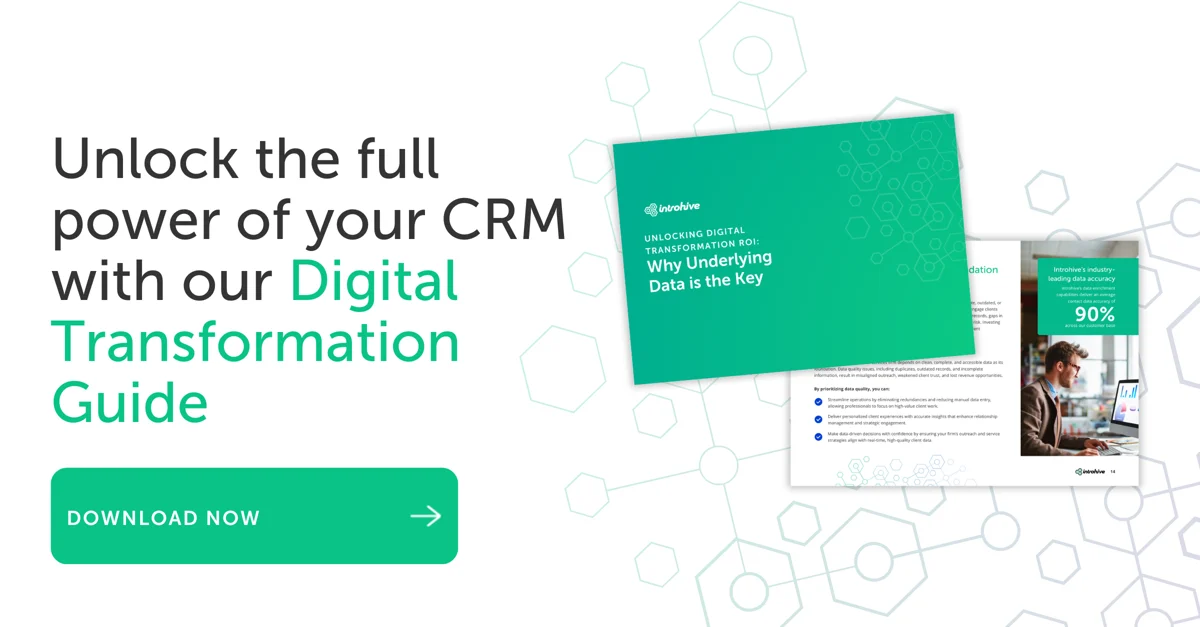While many firms once measured technology success during professional services transformation by logins and licenses, leaders today know the real question isn’t what they bought, but what business results those investments deliver.
At Introhive’s recent Client Summit, Beth More (Grassi), and Tom Harper (Blue & Co.), and Manny Ibrahim (Silicon Valley Bank) shared candid stories about how they measure ROI on their technology investments, and how those insights shape their broader professional services transformation efforts.
Their experiences show that ROI for marketing automation, AI, and CRM systems and dashboards isn’t about usage statistics or activity levels. Instead, it’s about strengthening relationships, fostering collaboration, and driving meaningful growth, and presenting those results in terms partners and firm leadership care about.
Table of contents
Here are the top three insider lessons they shared.
1. Redefine ROI around outcomes, not logins
For years, firms have relied on adoption metrics like logins, clicks, license counts as a proxy for success. But whether you’re critically assessing the tools you already have or considering a broader professional services transformation, leaders like Beth of Grassi and Tom of Blue & Co. have shown that those numbers rarely tell the full story of what technology is delivering to the business.
Beth described how, when she joined Grassi, conversations about ROI focused almost entirely on usage.
“They kept asking, ‘How many people are logging in? Are we getting adoption? This is really expensive,’” she recalled. “I stopped engaging in those conversations. It’s not about logins; it’s about how the data improves our marketing, drives growth, and saves time and money. That’s the conversation we should be having.”
By shifting the focus to outcomes like the quality and usefulness of client and referral data, the efficiency of campaigns, and time saved by automating manual work, Beth was able to show clear, measurable value. Over time, that mindset change even created what she called a healthy sense of “FOMO” among partners and staff, with more people asking for access after seeing how their colleagues benefited.
Tom at Blue & Co. came to a similar conclusion from a slightly different angle. For him, technology wasn’t just about internal efficiency, it was also about empowering business development and revenue-driving behaviors across a highly specialized and geographically dispersed team. His team now measures the impact of their tech investments, especially Introhive, through their ability to strengthen client relationships and drive high-quality one-on-one meetings with clients.

With over a dozen healthcare teams across three offices, the firm also used relationship intelligence to break down silos and optimize account coverage, ensuring the best team was assembled for each opportunity, regardless of office. These insights became so foundational that Introhive is now baked into growth plans for every healthcare partner and manager, and 40 monthly one-on-one meetings on growth are fueled by its analytics.
As Tom explained, “We use Introhive to see who has the best relationships, what the best team looks like to make a call, and what we want to deliver in that call.”
For both leaders, reframing ROI in terms of business outcomes like growth, efficiency, collaboration, rather than activity metrics, helped leadership and professionals alike see the tools as strategic assets instead of administrative burdens.
2. Build the business case for data-driven transformation
For many firms, the real measure of a technology investment isn’t whether people log in, but whether leadership can use the data to make better decisions. That shift, from activity metrics to business outcomes, came through clearly in how both Silicon Valley Bank and Blue & Co. approach ROI today.
At Silicon Valley Bank, Manny explained how his team designed a system to surface meaningful insights for management rather than bury them in reports nobody reads. Rather than judging ROI on CRM usage alone, they focused on creating dashboards that help leaders act.

“We take all the data from Introhive and CRM, feed it into our data warehouse, and then build dashboards that have the KPIs management cares about,” Manny said. “That’s how we show the payoff: we make the data visible, understandable, and actionable for our stakeholders. Once they can see it clearly, they can nudge behaviors and take the right next steps.”
This system now powers more than just reporting – it drives behavior. Leadership uses the dashboards to monitor client engagement targets based on tiering, identify missed opportunities, and ensure outreach happens when and where it matters. As Manny put it, the data provides objective clarity: “You ask someone how engaged they are with a client and it’s subjective. But the data tells the facts.”
This approach has also changed how leadership perceives the role of CRM and marketing automation, from just a tool for data entry to a strategic source of insight about client engagement, pipeline health, and relationship strength.
At Blue & Co., Tom described a similar cultural shift. He recalled that early CRM initiatives were bogged down by conversations about logins and compliance. Today, their dashboards have reframed the conversation entirely and raised expectations among partners by surfacing clear performance indicators.
“Now, I get calls from partners saying, ‘Tell me why I’m red and what I need to do to fix it,” Tom shared. “That’s when you know the tools are really working: when they spark meaningful conversations and actions, not just reports.”
For both firms, the business case for data has become much more compelling because it’s framed in the language of growth and client outcomes. Rather than chasing adoption numbers, they’ve focused on making the data trustworthy, easy to interpret, and tied directly to business decisions, so that leadership can see its value without being asked to “believe” in the tools.
3. Align ROI with leadership priorities during professional services transformation
All three leaders noted that it’s crucial to frame ROI in language that resonates with firm leadership and partners and not just technical success. In other words: revenue, client growth, and risk mitigation.
For Beth, that meant aligning marketing automation and CRM data with measurable growth and retention outcomes, and using clean, actionable data to support firmwide collaboration rather than internal competition. “We’re a referral-based business,” she explained. With Introhive, her team was able to identify their strongest banking and referral relationships, organize around key centers of influence, and minimize the internal friction that can naturally arise when multiple people claim ownership of the same relationships.
For Tom, that meant showing how their systems help partners focus on the right opportunities and deepen the right relationships, while keeping accountability front and center. This also resonates strongly for firms navigating change such as post-merger growth strategy or just beginning to think about how they approach M&A.
And for Manny, that meant giving management clear dashboards they could trust and act on, and choosing tools that integrate seamlessly, supporting the firm’s broader professional services transformation journey. “Either way, we know we’ll be able to leverage the data because the integrations are already there,” he noted.
Final thoughts on technology that proves its worth
Measuring technology ROI has evolved beyond tracking logins and licenses. The firms featured here demonstrate that the real measure of success lies in how tools enable stronger client relationships, foster collaboration, and fuel meaningful growth, all of which are cornerstones of effective professional services transformation.
Whether you’re evaluating your first CRM, reassessing a system that isn’t delivering, or optimizing a mature tech stack, you can measure ROI in ways that resonate with leadership and support your broader professional services transformation goals.
As Beth from Grassi put it: “It’s not about logins. It’s about how it improves marketing, drives growth, and saves time and money. That’s the conversation we should be having.”
Want to see how Introhive helps firms measure and maximize the value of their technology investments? Request a demo. Or check out our Digital Transformation Guide for practical steps to measure ROI, foster collaboration, and drive meaningful digital transformation.






